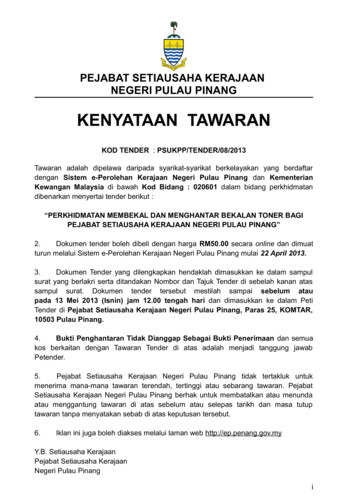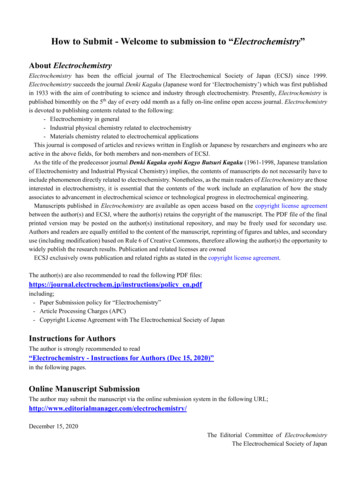21.4 Electric Field And Electric Forces - Weebly
21.4 Electric Field and Electric ForcesHow do charged particles interact in empty space?How do they know the presence of each other?What goes on in the space between them? Body A produces an electric field at P as aconsequence of the charge on body A onlyM. Moodley, 20091
Place test charge q0 at P – if q0 feels an electricforce, then there is an electric field at that point The electric field is the intermediary throughwhich A communicates its presence to q0 The electric field that A produces exists at allpoints in the region around AM. Moodley, 20092
Definition: The Electric FieldThe electric field at a point is the electric forceexperienced by a test charge q0 at that point dividedby the charge q0. electric force per unit charge SI unit is N/C force exerted on q0 by anelectric field:M. Moodley, 20093
Note: force exerted by q0 on A may cause the chargedistribution on A to be shifted electric field around A may be different if q0 ispresent if q0 is very small, redistribution of charge on A isalso very small therefore, correct definition of electric field is:M. Moodley, 20094
Some terminology:unit vectorsourcepointfieldpointReminder (from mechanics):unit vectorwhereM. Moodley, 20095
field created by ve chargeq at P points away from q inthe same direction asfield created by -ve chargeq at P points toward q in theopposite direction fromM. Moodley, 20096
magnitudes:The vector equation for the electric field ofa point charge :M. Moodley, 20097
E-field varies from point to point – is an infinite setof vector quantities vector field field strength decreases with increasing distanceField pattern for apositive charge qM. Moodley, 20098
Example: Electric-field vector for a point chargeA point charge q -8.0 nC is located at the origin. Find theelectric-field vector at the field point x 1.2 m, y -1.6 m.M. Moodley, 20099
Example: Electron in a uniform E-fieldConsider a uniform E-field set up by the configuration below.The two horizontal parallel conducting plates are a distance 1.0cm apart and are connected to a 100 V battery. The magnitude ofthe E-field created is E 1.00 x 104 N/C and points verticallyupwards. (neglect gravitational forces)a) If an electron is released from rest at the upper plate, what isits acceleration?(electron: charge -e -1.60 x 10-19 C and mass m 9.11 x 10-31 kg)M. Moodley, 200910
Example: Electron in a uniform E-field . continuedb) What speed and kinetic energy does it acquire whiletravelling 1.0 cm to the lower plate?c) How much time is required for it to travel this distance?(electron: charge -e -1.60 x 10-19 C and mass m 9.11 x 10-31 kg)M. Moodley, 200911
Example: Electron in a uniform E-field . continuedd) If an electron is launched into the E-filed with an initialhorizontal velocity v0, what is the equation of itstrajectory?Parabolic trajectory of an electron in a uniform E-fieldM. Moodley, 200912
21.5 Electric-Field Calculations in realistic situations charge is distributed over space distribution made up of many point chargesq1, q2, q3 . . . . at each point P, each charge produces its own electricfield E1, E2, E3 . . . so test charge q0 placed at P experience forcesF1, F2, F3 . . . due to q1, q2, q3 . . . .Pcharge distributionM. Moodley, 200913
q0Ptest charge at Pcharge distributionFrom superposition principle, total force F0 thatcharge distribution exerts on q0 :Total electric field E at point P :(principle of superposition of electric fields)M. Moodley, 200914
Different charge distributions:line charge distribution linear charge density (charge per unit length, C/m)surface charge distribution surface charge distribution (charge per unit area, C/m2)volume charge distribution volume charge density (charge per unit volume, C/m3)M. Moodley, 200915
Example: Field of an electric dipolePoint charges q1 12 nC and q2 -12 nC are placed 10 cm apart.Compute the E-field caused byq1, the field caused by q2, andthe total fielda) at point a;b) at point b; andc) at point cM. Moodley, 200916
Example: Field of a ring of chargeA ring-shaped conductor with radius a carries a total charge Quniformly distributed around it. Find the E-field at a point Pthat lies on the axis of the ring at a distance x from its centre.M. Moodley, 200917
Example: Field of a line of chargePositive electric charge Q is distributed uniformly along a linewith length 2a, lying along the y-axis between y -a and y a.Find the E-field at P on the x-axis at a distance xfrom the origin.M. Moodley, 200918
Example: Field of a uniformly charged diskFind the E-field caused by a disk of radius R with a uniformpositive surface charge density , at a point along the axis ofthe disk a distance x from its centre.M. Moodley, 200919
Example: Field of two oppositely charged sheetsTwo infinite plane sheets are placed parallel to each other,separated by a distance d. The lower sheet has a uniformpositive surface charge density , and the upper sheet has auniform negative surface charge density - with the samemagnitude. Find the E-field between the sheets, above theupper sheet and below the lower sheet.M. Moodley, 200920
21.6 Electric Field LinesHelp in the visualization of electric fields: electric fields can be represented by electric fieldlines at various points in space it is an imaginary line or curve drawn through aregion of space so that its tangent at any point is inthe direction of the electric field vector at that pointM. Moodley, 200921
These lines start on a positivecharge and end on anegative charge The number of field linesstarting (ending) on a positive(negative) charge isproportional to the magnitudeof the charge The electric field is strongerwhere the field lines arecloser together only one field line can pass through each point of thefield - field lines never intersectM. Moodley, 200922
Different electric fieldline configurationsan electric dipoleM. Moodley, 200923
21.7 Electric DipolesAn electric dipole is a pair of point charges with equalmagnitude and opposite charge separated by a distance d.Water molecules (H2O) behave like electric dipoles:net positive charge it is electrically neutral chemical bonds cause adisplacement of charge is an excellent solventnet negative chargeM. Moodley, 200924
Force and Torque on an Electric DipoleConsider an electric dipole in a uniform electric field E the net force on it is zero different line of actionimplies torques don't addto zeroM. Moodley, 200925
Let's calculate the torque: w.r.t. centre of dipole lever arm for bothforces is torque for both forces is magnitude of the net torque: is directed into the page since both torques rotatethe dipole clockwise product of q and d is the magnitude of the electricdipole moment, denoted by p:(unit of C.m) is a vector, direction along axis of dipole (-ve to ve)M. Moodley, 200926
In terms of p, the magnitude of the net torque is: this is a vector product between vectors p and E : use right-hand rule to get direction of the torque torque is greatest when p is perpendicular to E is zero when p and E are parallel or anti-parallel torque always tends to turn p to line up with E 0 (p E) position of stable equilibrium (p anti- E) position of unstableequilibriumM. Moodley, 200927
When the dipole changes direction in an E-field, thetorque does work on it.Work:for an infinitesimal displacement torque is in direction of decreasing implies In a finite displacement from 1 to 2 the total workdone on the dipole isM. Moodley, 200928
Potential energy for a dipole in an E-field: work is the negative of the change in potential energy potential energy can therefore be defined asscalar product U is minimum at 0 (p E) U -pE U is maximum at (p anti- E) U pE U is zero at /2 (p E) U 0M. Moodley, 200929
Example: Force and torque on an electric dipoleConsider an electric dipole in a uniform E-field with magnitude5.0 x 105 N/C. The two charges are of magnitude 1.6 x 10-19 Cand are separated by a distance of 0.125 nm. Finda) net force exerted by the fieldon the dipoleb) the electric dipole momentc) the torqued) potential energy of the systemM. Moodley, 200930
Example: Force and torque on an electric dipole Consider an electric dipole in a uniform E-field with magnitude 5.0 x 105 N/C. The two charges are of magnitude 1.6 x 10-19 C and are separated by a distance of 0.125 nm. Find a) net force exerted by the field on the dipole b) the electric dipole
The electric field is stronger where the field lines are closer together. 16.8 Field Lines Electric dipole: two equal charges, opposite in sign: 16.8 Field Lines The electric field between two closely spaced, oppositely charg
16.8 Field Lines The electric field between two closely spaced, oppositely charged parallel plates is constant. 16.8 Field Lines Summary of field lines: 1. Field lines indicate the direction of the field; the field is tangent to the line. 2. Th
Introduction to Maxwell’s Theory Z X Y Q1 Q2 F2 1 E ( r ) THE ELECTRIC FIELD Figure 4.1: The Electric Field and Electric Forces Maxwell said that electric and magnetic forces were due to the presence of the electric and magnetic field. In this figure, the electric force on Q 2 is due to the presence of the field at its location, F 21 .
duppattas - six electric bell - two electric fans - three electric hand dryer-two electric iron - one electric lamps / wall-six electric organ-one electric shavers-two electric table lamp-two electric toaster-one empty receptacle
However, electric furnaces can accommodate central cooling easier than zonal electric heating, because the air conditioner can share the furnace’s ducts. Electric resistance heat can be provided by electric baseboard heaters, electric wall heaters, electric radiant heat, electric space heaters, electric f
20.1 Electric Charge and Static Electricity The effect an electric charge has on other charges in the space around it is the charge’s electric field. An electric field exerts forces on any charged object placed in the field
field lines form closed loops unlike electric field lines Magnetic Field Just like the electric field that surrounds electric charge, the magnetic field surrounds a magnet What does this mean? –Magnetic force is also a field force –The force one magnet exerts onto another can be
The electric field between two closely spaced, oppositely charged parallel plates is constant. Field Lines . Summary of field lines: 1.Field lines indicate the direction of the field; the field is tangent to the line. 2.Th























